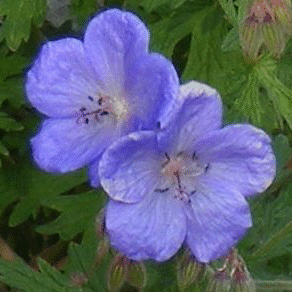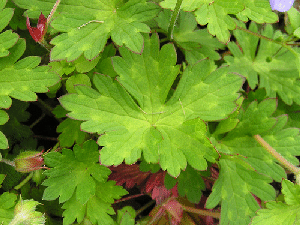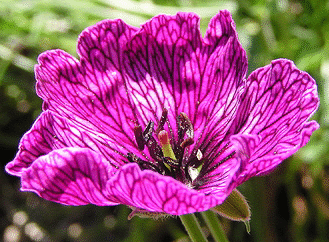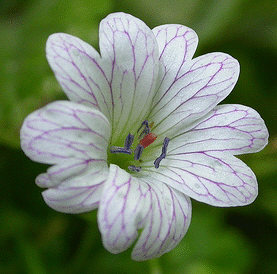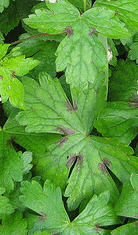Cranesbill Geranium
Cranesbill, long living perennial geranium that blooms all season
Not to be confused with annual geranium, or pelargoniums, cranesbill is the true hardy Geranium species. Cranesbill, like many genus in the Geranium species, disperse seeds after petals have faded and dropped from a beak like pod (similar to a crane’s bill) that casts seeds some distance. All Cranesbill are perennial and fairly hardy and generally long lived. Most prefer full sun and a rich well drained soil but are not particularly fussy as long as the soil is well drained. Afternoon shade will benefit most cranesbill in hot climates. After flowering, a severe shearing benefits the foliage and encourages additional blooming. Shearing the spent blooms will also prevent self seeding. Cranesbill foliage is quite lovely with a delicate appearance when out of bloom. Once established, Cransebill require very little care and generally can tolerate short drought period. They generally bloom for a long period beginning as early as May and often continuing until frost if deadheaded.
Geranium ibericum x ‘Johnson’s Blue Cranesbill’
Common Name: Hardy Geranium, Geranium himalayense ‘Johnson’s Blue’
Plant Type: Herbaceous perennial
Height: 15-18”
Spread: 24-36”
Sun/Shade Requirements: Full sun to part sun
Water Requirements: Average water needs, prefers a well drained soil. Prefers weekly watering, more in extreme heat.
Soil Requirements: Prefers loamy or sandy well drained soil with a neutral pH.
Growth Habit: Mounded, becoming more sprawling as the growing season progresses.
Bloom Time: Spring to fall
Bloom Color: Blue violet
Bloom Form: 1 1/2-2” cup shaped, 5 petal flowers, widely open to a flat saucer
Foliage: Large green, finely cut divided
Fragrance: None
Pest and Disease Resistance: Not typically bothered by pests. In wet humid conditions is susceptible to root rot, mold, powdery mildew, leaf spot and rust.
Fertilize: Apply a balanced fertilizer in early spring. If a severe shearing or cut back to the ground is necessary, fertilize as the foliage begins to regrow. Over fertilizing can cause the plant to become sprawling and lanky.
Maintenance: Easy to care for with regular watering.
Other: Propagates by division. Somewhat tolerant of urban conditions.
Hardiness: Zones 4-8
‘Johnson’s Blue’ is considered to have the truest blue flower of the Cranesbills. It grows quite quickly with lovely dense foliage to fill an open space. Large blue blooms with darker veining are held in clusters above the foliage, giving the plant in bloom an airy appearance. After blooming, ‘Johnson’s Blue’ can look pretty floppy and scraggly with numerous bare, branched flower stems. The foliage may also become quite sprawling and leggy. Remove the flower stems and as much as the foliage as is necessary to achieve a neat appearance, cutting back to the ground if need be. Simply shear it back with a garden shear, and fresh foliage will emerge as well as additional blooms.
When foliage remains fresh, which it may in full sun and with not too much fertilize, it adds elegant texture to the garden. Lovely mounds of large, deeply cut lobed leaves are terrific in both casual and formal plantings. An occasional tiny plant may pop up from self seeding, either remove or plant elsewhere. Division is rarely necessary other than to propagate additional plants. Excellent as a softening transition against hardscapes or as an accent plant. ‘Johnson’s Blue’ is a perfect woodland garden plant if the site is not too shady.
‘Johnson’s Blue’ has been a garden staple for a very long time, and has been considered the classic blue Cranesbill. New hybrids should also be considered when making a selection. ‘Rozanne’ has a longer bloom period and does not get quite so scraggly after blooming. A heavy layer of mulch is helpful in zones 3 and 4 to protect the roots. ‘Johnson’s Blue’ is a pretty adaptable and easy to care for perennial that will generally live for ten years or more.
Geranium x ‘Rozanne’
Common Name: Hardy Geranium, Rozanne Cranesbill, Blood Red Cranesbill
Plant Type: Herbaceous perennial
Height: 18-20”
Spread: 24”
Sun/Shade Requirements: Full sun to part shade
Water Requirements: Low to average water needs, prefers a well drained soil.
Soil Requirements: Prefers loamy or sandy well drained soil with a neutral pH.
Growth Habit: Mounded, becoming more sprawling as the growing season progresses.
Bloom Time: June until frost
Bloom Color: Violet blue with lighter eyes
Bloom Form: 1 1/2-2 1/2” saucer shaped flowers
Foliage: Deep green finely divided
Fragrance: None
Pest and Disease Resistance: Not typically bothered by pests. In wet humid conditions is susceptible to root rot, mold, powdery mildew, leaf spot and rust.
Fertilize: Apply a balanced fertilizer in early spring. If a severe shearing or cut back to the ground is necessary, fertilize as the foliage begins to regrow. Over fertilizing can cause the plant to become sprawling and lanky.
Maintenance: Very easy care
Other: Propagates by division.
Hardiness: Zones 4-9
‘Rozanne’ was introduced in the early 2000s, and quickly become a gardening favorite. It is probably the best blooming Cranesbill, flowering non stop from early summer through late fall. The foliage forms a compact, horizontal mound that does not get leggy and shaggy. Sun to half day shade is ideal, and just about any soil condition suits ‘Rozanne’ just fine. Extremely hardy, ‘Rozanne’ can survive as far north as zones 2 and 3 with heavy mulching.
‘Rozanne’s’ powdery violet blue blooms float delicately above the foliage. Leaves are a deep green and slightly marbled with chartreuse. Although the foliage holds up better than other Cranesbills, pruning and deadheading will still be necessary if you prefer to keep the plant neat and fresh. Shear off the spent blooms and prune out fading foliage at ground level. New foliage will quickly emerge, as well as a new batch of blooms. Growing in full to mostly sun will help keep the plant looking its’ best, and don’t overdo the fertilizer. ‘Rozanne’ is a sterile hybrid and will not self seed.
Heat and humidity are no problem for ‘Rozanne’, but be sure to water weekly in extreme heat. A little afternoon shade will benefit the plant in hot summer regions. ‘Rozanne’ is great tucked in or spilling over just about anywhere, and is perfect for edging a perennial border. Drought tolerant enough to hold up in rock gardens and street plantings.
Geranium x ‘Brookside’
Common Name: Hardy Geranium
Plant Type: Herbaceous perennial
Height: 16-24”
Spread: 24”
Sun/Shade Requirements: Full sun to part shade
Water Requirements: Average water needs, prefers a well drained soil. Requires weekly watering, more often in extreme heat
Soil Requirements: Prefers loamy or sandy well drained soil with a neutral pH, but will tolerate alkaline and clay if well drained.
Growth Habit: Mounded, becoming more sprawling as the growing season progresses.
Bloom Time: End of May into June, repeating into August or September
Bloom Color: Blue lavender with a little purple veining and white centers.
Bloom Form: Large Cup shaped
Foliage: Green, fine and deeply cut foliage.
Fragrance: None
Pest and Disease Resistance: Not typically bothered by pests. In wet humid conditions is susceptible to root rot, mold, powdery mildew, leaf spot and rust.
Fertilize: Apply a balanced fertilizer in early spring. If a severe shearing or cut back to the ground is necessary, fertilize as the foliage begins to regrow. Over fertilizing can cause the plant to become sprawling and lanky.
Maintenance: Easy to grow and care for.
Other: Propagates by division.
Hardiness: Zones 4-8
‘Brookside’ blooms every bit as long or longer than ‘Rozanne’ and has one of the largest flowers of the blue varieties. By many it is preferred over ‘Johnson’s Blue’ with a better “true” blue, and some say it is the best blue Geranium. Lacy deeply cut foliage is pretty heat resistant, holding a fresh look through most of summer. If it gets tattered looking, sheer back the spent flower stems and prune out poor looking foliage at the ground level. Fresh foliage will emerge and blooming will begin again.
‘Brookside’s’ foliage grows rapidly in spring, forming an upright mound and spreading wide slowly. If it spreads too wide, divide ‘Brookside’ in spring or fall every few years. In cool climates full to mostly sun is ideal, morning sun or some afternoon shade is best in warmer regions. Foliage turns orange red in autumn.
‘Brookside’ is fairly adaptable to either dry or moist conditions and is not fussy about pH or soil, except that is does require well drained soil. It is also somewhat tolerant of urban conditions. Expect ‘Brookside’ to live about 10 years.
Most are long bloomers, some self seed (watch for tiny plants to pop up, to either remove or plant elsewhere). Full sun is preferred but some can tolerate light shade, especially further south. The cultivar Rozanne is very tolerant of heat and humidity and has one of the longest bloom season of the Crane’s bills. It is also very compact, making it a great choice for containers and garden borders. Winter protection is suggested in zones 3 and 4, use 3-4 inches of mulch.
Cranesbill x ‘Jolly Bee’
Common Name: Hardy Geranium, Cranesbill Geranium
Plant Type: Herbaceous perennial
Height: 16-24”
Spread: 23-30”
Sun/Shade Requirements: Full sun to part shade
Water Requirements: Low to average water needs, prefers a well drained soil.
Soil Requirements: Prefers loamy or sandy well drained soil with a neutral pH, but is tolerant of average soil if well drained.
Growth Habit: Mounded, becoming more sprawling as the growing season progresses.
Bloom Time: May through October
Bloom Color: Blue violet with white center
Bloom Form: Cup shaped
Foliage: Green finely divided
Fragrance: None
Pest and Disease Resistance: Not typically bothered by pests. In wet humid conditions is susceptible to root rot, mold, powdery mildew, leaf spot and rust.
Fertilize: Apply a balanced fertilizer in early spring. If a severe shearing or cut back to the ground is necessary, fertilize as the foliage begins to regrow. Over fertilizing can cause the plant to become sprawling and lanky.
Maintenance: Easy to care for. Deadhead to encourage blooming.
Other: Propagates by division.
Hardiness: Zones 4-8
Like most of the newer Cranesbill hybrids, ‘Jolly Bee’ is a prolific bloomer. Large violet blue blooms are veined in violet red with white centers. In cool summers, the bloom color will be a deeper blue. The foliage is a medium green with bright marbled highlights. ‘Jolly Bee’ has a bit better mounding habit than ‘Rozanne’, which has a more horizontal habit. Otherwise, ‘Jolly Bee’ is considered nearly identical to ‘Rozanne’. ‘Jolly Bee’ is well behaved and will do a lovely job in a perennial border, fronting hedges or foundation plantings or as an accent plant. And it looks great spilling over landscape walls or nestled in a rock garden.
‘Jolly Bee’ is an easy to grow and care for perennial. It has fairly good heat tolerance, is not fussy about soil type or pH, and will tolerate urban pollution. Moist conditions are tolerated if the soil is well drained. Like other Cranesbill, ‘Jolly Bee’ may need rejuvenation by mid to late summer. Shear off spent blooms and stems for a neater appearance and remove any foliage that has deteriorated. New foliage will quickly emerge and blooming will begin shortly thereafter. Blooming is fairly continuous without deadheading, but may be improved by removing the spent blooms and stems. Although ‘Jolly Bee’ does self seed, the seeds are rarely viable, so don’t expect to see new plants pop up. Divide in spring or fall to propagate new plants. Expect ‘Jolly Bee’ to live about 10 years.
Geranium x cantabrigiense ‘Biokovo’
Common Name: Hardy Geranium, Cambridge Geranium
Plant Type: Herbaceous perennial
Height: 6-10”
Spread: 10-24”
Sun/Shade Requirements: Full sun to part shade
Water Requirements: Low to average water needs, prefers a well drained soil. Drought tolerant.
Soil Requirements: Not fussy about soil type or pH.
Growth Habit: Mounded, spreading
Bloom Time: June through July, reblooming through September
Bloom Color: Shell pink with rose centers
Bloom Form: 5 petal 3/4” cup saucer flowers
Foliage: Dark green, finely divided rounded lobes.
Fragrance: Foliage has a light spicy scent.
Pest and Disease Resistance: Not typically bothered by pests. In wet humid conditions is susceptible to root rot, mold, powdery mildew, leaf spot and rust.
Fertilize: Apply a balanced fertilizer in early spring only where soil is exceptionally poor. Over fertilizing will cause the plant to spread aggressively.
Maintenance: Easy to grow and care for
Other: Propagates by division or cuttings, deer resistant.
Hardiness: Zones 4-8
‘Biokovo’ is a delightful Cranesbill with delicate pink blooms and rose eyes and stamens. The flowers open into a cup shape, then open wide to a flat saucer, eventually almost turning backward toward the stems. The initial bloom period will last up to five weeks, lighter reblooming continuing into late summer. Deadheading spent blooms will encourage the reblooming. The dense foliage is ferny and ground hugging, making it excellent as a groundcover, especially for dry shady areas. Its’ dwarf stature also makes it a wonderful choice for edging a perennial border or garden walk, or as an accent plant in a rock garden. It adapts well to moist or dry conditions, but does prefer well drained soil. In regions with hot summer, the plant will benefit from afternoon shade.
‘Biokovo’ will spread by underground rhizomes, so give it some room or plan to divide every 3 or 4 years to control size. A mature plant may spread to as much as three feet wide. If grown in fertile soil that receives regular water and fertilizer, ‘Biokovo’ will spread aggressively. Foliage turns several shades of reds, orange and golden in autumn. A light spicy scent comes from the foliage. Under ideal growing conditions you can expect ‘Biokovo’ to live about ten years. ‘Biokovo’ is a very tough perennial, an excellent variety of hardy geranium.
Geranium cinereum ‘Ballerina’
Common Name: Hardy Geranium, Alpine Geranium, Greyleaf Cranesbill
Plant Type: Herbaceous perennial
Height: 6-8”
Spread: 12-15”
Sun/Shade Requirements: Full sun to part shade
Water Requirements: Low to average water needs, prefers a well drained soil. Drought tolerant once established.
Soil Requirements: Not fussy about pH or soil type if the soil is well drained.
Growth Habit: Mounded
Bloom Time: May into July, reblooming through September
Bloom Color: Pink veined with purple
Bloom Form: 2” Cup shaped
Foliage: Green finely divided
Fragrance: Foliage is lightly fragrant.
Pest and Disease Resistance: Not typically bothered by pests. In wet humid conditions is susceptible to root rot, mold, powdery mildew, leaf spot and rust.
Fertilize: Apply a balanced fertilizer in early spring. Over fertilizing can cause the plant to become sprawling and lanky or spread aggressively..
Maintenance: Very easy to grow and care for.
Other: Propagates by division, deer resistant.
Hardiness: Zones 3-9
‘Ballerina’s’ dainty blooms are lilac pink with crimson pink veining and dark purplish centers. The finely veined petals are dramatic when viewed up close, so this is an excellent choice for an entry garden or in containers. ‘Ballerina’ is an early bloomer, and will continue light blooming well into fall if deadheaded. The foliage forms a dense mat to make an ideal ground cover, perfect as an under planting.
‘Ballerina’ is a tough and vigorous perennial that tolerates heat and humidity as well as urban conditions. It does very well as an alpine plant, it is a native in the Pyrenees mountains. It loves cool nights and is very cold hardy. When planted in regions with hot summers, afternoon shade will benefit the plant. ‘Ballerina’ spread through underground rhizomes, but not aggressively. Self seeding is limited. In general, ‘Ballerina’ does not need feeding unless soil is exceptionally poor. It will thrive on neglect.
Geranium sanguinium x ‘Tiny Monster’
Common Name: Hardy Geranium
Plant Type: Herbaceous perennial
Height: 12-18””
Spread: 18-36”
Sun/Shade Requirements: Full sun to part sun
Water Requirements: Low to average water needs, prefers a well drained soil. Drought tolerant once established.
Soil Requirements: Prefers loamy or sandy well drained soil with a neutral pH.
Growth Habit: Mounded
Bloom Time: May through October
Bloom Color: Bright magenta
Bloom Form: 1-1 1/2” Cup shaped
Foliage: Green, deeply cut fine foliage
Fragrance: None noted.
Pest and Disease Resistance: Not typically bothered by pests. In wet humid conditions is susceptible to root rot, mold, powdery mildew, leaf spot and rust.
Fertilize: Apply a balanced fertilizer in early spring. If a severe shearing or cut back to the ground is necessary, fertilize as the foliage begins to regrow. Over fertilizing can cause the plant to become sprawling and lanky.
Maintenance:
Other: Propagates by division.
Hardiness: Zones 5-8
Vivid magenta flowers with red purple veining are produced nonstop all summer on ‘Tiny Monster’. Blooms are held 4-6” above the foliage on branched stems from late spring through late summer. The plant spreads quickly to form a dense mound that remains quite fresh all season, turning rich red in autumn in cold climates. Plant in full to part sun so the foliage doesn’t sprawl and fewer flowers are produced. In regions with hot summers, afternoon shade will benefit ‘Tiny Monster’.
‘Tiny Monster’ is sterile and will not self seed, which also allows longer flowering period. The heaviest blooming is usually about June through August. Deadheading spent blooms will encourage continued blooming. If foliage does become ragged, just snip out near the ground and new foliage will quickly emerge.
‘Tiny Monster’ is a stunning ground cover or when planted in masses. Blooms are vivid and long lasting enough to use as an accent plant or creates a wonderful border for a perennial garden.. Drought tolerance makes it an excellent filler in a rock garden.
Geranium cinereum ‘Purple Pillow’
Common Name: Hardy Geranium, Cranesbill Geranium, ‘Ravpil’
Plant Type: Herbaceous perennial
Height: 6-8”
Spread: 12-24”
Sun/Shade Requirements: Full sun to part shade
Water Requirements: Low to average water needs, prefers a well drained soil.
Soil Requirements: Prefers loamy or sandy well drained soil with a neutral pH, but not fussy.
Growth Habit: Compact and mounded
Bloom Time: May through June, reblooming through September
Bloom Color: Red purple with distinct dark veining
Bloom Form: 1” cup shaped
Foliage: Silvery green leaves, deeply lobed
Fragrance: Foliage is lightly fragrant.
Pest and Disease Resistance: Not typically bothered by pests. In wet humid conditions is susceptible to root rot, mold, powdery mildew, leaf spot and rust.
Fertilize: Apply a balanced fertilizer in early spring. If a severe shearing or cut back to the ground is necessary, fertilize as the foliage begins to regrow. Over fertilizing can cause the plant to become sprawling and lanky.
Maintenance: Very easy to grow and care for.
Other: Propagates by division.
Hardiness: Zones 4-8
‘Purple Pillow’s’ vivid blooms are a show stopper. Rich purple red flowers are held above delicate foliage. The foliage has a silvery shimmer in sunlight and the purple tinged leaves turn coppery in autumn. ‘Purple Pillow’ prefers a moist, very well drained soil, it is quite drought tolerant once established. In cooler regions grow in full to mostly sun. Afternoon sun will benefit the plant in regions with hot summers.
‘Purple Pillow’ is stunning in masses or as an accent plant. The dwarf stature lends ‘Purple Pillow’ well to underplanting, edging perennial beds, or fronting foundation plantings. As a groundcover, ‘Purple Pillow’ is not quite as dense as other dwarf Cranesbill. It will cover an area nicely, but may not be dense enough to prohibit weed growth. Shear the plant back lightly after flowering to encourage new growth from the center and to encourage reblooming.
Geranium sanguineum ‘Bloody Cranesbill’
Common Name: Hardy Geranium
Plant Type: Herbaceous perennial
Height: 9-12”
Spread: 9-12”
Sun/Shade Requirements: Full sun to part shade
Water Requirements: Low to average water needs, prefers a well drained soil.
Soil Requirements: Prefers loamy or sandy well drained soil with a neutral pH.
Growth Habit: Dense leafy mound
Bloom Time: June through August
Bloom Color: Violet with darker veining.
Bloom Form: Cup shaped, opening wide to nearly flat.
Foliage: Green, deeply divided
Fragrance: None
Pest and Disease Resistance: Not typically bothered by pests. In wet humid conditions is susceptible to root rot, mold, powdery mildew, leaf spot and rust.
Fertilize: Apply a balanced fertilizer in early spring. If a severe shearing or cut back to the ground is necessary, fertilize as the foliage begins to regrow. Over fertilizing can cause the plant to become sprawling and lanky.
Maintenance: Very easy to grow and care for.
Other: Propagates by seed or division.
Hardiness: Zones 3-8
‘Bloody Cranesbill’ is the species plant that many cultivars originate from. It is a British native wildflower and blooms prolifically with little encouragement. Blooms may appear as early as early May, but the primary bloom period is Late May through June. Deadheading will encourage continued blooming. The leaves of ‘Bloody Cranesbill’ are more deeply cut than other hardy geraniums, lending a very delicate appearance, a lovely foliage when out of bloom. The foliage may get a bit ragged and sprawling after the first bloom period, a hard shearing will rejuvenate the plant and blooming will begin again.
‘Bloody Cranesbill’ is generally not invasive, but it ideal conditions, such as rich, moist soil and frequent fertilizing, it can spread quite rapidly. It will self seed lightly, but the new plants may not come up true, particularly if other Cranesbill are grown nearby. Foliage turns a vibrant crimson in autumn, hence its’ name. A thick layer of mulch in zone 4 may be beneficial through winter, and may even survive in zone 3 when heavily mulched.
‘Nanum’ is a dwarf version of this species plant, growing to about 8” it is more companct. Flowers are more cup shaped and ‘Nanum’ blooms more prolifically. Both make an excellent ground cover or border edging. Heat tolerant enough for a rock garden, but it may need supplemental water in extended dry period.
Geranium versicolor ‘Pencilled Geranium’
Common Name: Pencilled Cranesbill, Veined Geranium
Plant Type: Semi-evergreen herbaceous perennial
Height: 18-24”
Spread: 18-24”
Sun/Shade Requirements: Full sun to part shade
Water Requirements: Average water needs, prefers a well drained soil. Somewhat drought tolerant once established but in hot periods will prefer regular watering.
Soil Requirements: Prefers loamy or sandy well drained soil with a neutral pH.
Growth Habit: Mounded clump forming
Bloom Time: June to August.
Bloom Color: White to pink with magenta veining
Bloom Form: 1 - 1 1/2” funnel shaped with five notched petals.
Foliage: Light green broad lobed and deeply toothed leaves, often with brown markings.
Fragrance:
Pest and Disease Resistance: Not typically bothered by pests. In wet humid conditions is susceptible to root rot, mold, powdery mildew, leaf spot and rust.
Fertilize: Apply a balanced fertilizer in early spring. If a severe shearing or cut back to the ground is necessary, fertilize as the foliage begins to regrow. Over fertilizing can cause the plant to become sprawling and lanky.
Maintenance:
Other: Propagates by seed or division.
Hardiness: Zones 4-8
‘Pencilled Geranium’ has exquisite petals of white or shades of pink with distinct purple veining that appears to be drawn on with a colored pencil. This species perennial is a wildflower native to the Balkans and Italy, and is a parent of several hybrid Cranesbills. The flowers are on the small side, but it does flower prolifically from June to August and may flower sporadically through October . It will bloom even in fairly heavy shade, but will do best with at least part sun. In regions with hot summer, part shade especially in the afternoon will benefit the plant.
‘Pencilled Geranium; will naturalize well and be quite at home in a casual cottage garden. Excellent in a woodland garden if the soil is moist. Will form a dense enough mat for a groundcover. “Pencilled Geranium’ is a tough perennial that will adapt to a wide range of conditions. The best source for this Geranium is a wildflower seed company.
